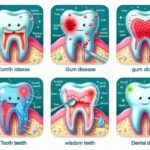Tooth decay, also known as dental caries or cavities, is a common dental problem that affects people of all ages. Understanding the causes, recognizing symptoms, and knowing how to prevent and treat tooth decay is essential for maintaining optimal oral health. Let’s explore tooth decay in detail:
Key Takeaways:
- Tooth decay is caused by the erosion of tooth enamel due to acids produced by bacteria in plaque.
- Symptoms of tooth decay include tooth sensitivity, pain, visible pits or holes in teeth, and discoloration.
- Prevention of tooth decay involves good oral hygiene practices, a balanced diet, and regular dental check-ups.
Causes of Tooth Decay:
Tooth decay occurs when bacteria in plaque feed on sugars and starches from food and produce acids that weaken and erode tooth enamel. Factors that contribute to tooth decay include:
- Poor Oral Hygiene: Inadequate brushing and flossing allow plaque to build up on teeth, increasing the risk of decay.
- Diet: Consuming sugary and acidic foods and drinks provides fuel for bacteria to produce acids that damage enamel.
- Dry Mouth: Reduced saliva flow can lead to an imbalance in oral bacteria and increase the risk of decay.
- Certain Medical Conditions: Conditions that cause acid reflux or dry mouth can contribute to tooth decay.
- Genetics: Some individuals may be more prone to tooth decay due to genetic factors affecting enamel strength and saliva composition.
Symptoms of Tooth Decay:
Symptoms of tooth decay may vary depending on the severity and location of the decay. Common signs include:
- Tooth Sensitivity: Sensitivity to hot, cold, sweet, or acidic foods and beverages.
- Tooth Pain: Persistent or intermittent toothache, especially when biting down or applying pressure.
- Visible Pits or Holes: Holes or dark spots on the surface of teeth may indicate decay.
- Discoloration: White, brown, or black spots on teeth may indicate early signs of decay.
- Bad Breath: Persistent bad breath (halitosis) may be a sign of advanced decay or infection.
Treatment of Tooth Decay:
Treatment for tooth decay depends on the severity of the condition. Common treatment options include:
- Dental Fillings: If decay is detected early, the affected portion of the tooth can be removed and filled with materials such as amalgam or composite resin.
- Root Canal Therapy: If decay reaches the inner pulp of the tooth, root canal therapy may be necessary to remove infected tissue and restore the tooth.
- Dental Crowns: In cases of extensive decay or damage, a dental crown may be placed to strengthen and protect the tooth.
- Tooth Extraction: In severe cases where the tooth is extensively decayed and cannot be saved, extraction may be necessary.
Prevention of Tooth Decay:
Preventing tooth decay involves adopting good oral hygiene habits and making healthy lifestyle choices:
- Brushing and Flossing: Brush teeth at least twice a day with fluoride toothpaste and floss daily to remove plaque and food particles.
- Balanced Diet: Limit sugary and acidic foods and drinks, and choose tooth-friendly snacks like fruits, vegetables, and cheese.
- Fluoride: Use fluoride toothpaste and mouthwash to strengthen enamel and prevent decay.
- Regular Dental Check-ups: Schedule dental exams and cleanings every six months for professional evaluation and preventive care.
- Dental Sealants: Consider dental sealants, especially for children, to protect vulnerable molars from decay.
In conclusion, tooth decay is a common but preventable dental problem that can lead to pain, infection, and tooth loss if left untreated. By practicing good oral hygiene, making healthy dietary choices, and seeking regular dental care, you can minimize your risk of tooth decay and maintain a healthy, beautiful smile for life. Remember, prevention is key, but if you experience any symptoms of decay, don’t hesitate to seek professional dental treatment promptly.













